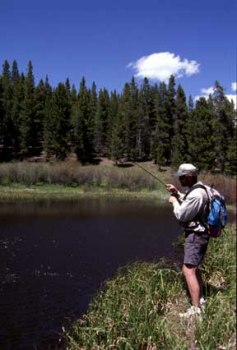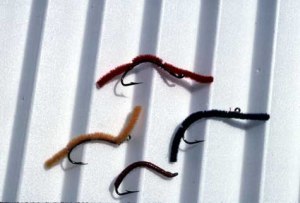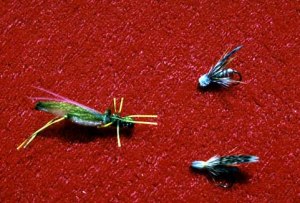Fishing the Unhatches
by Al
Marlowe |
Click
Here to read
more "Fish Tails"
|
Hatches
like the Salmon Fly, March Brown, or Green Drake offer exceptional
fishing. When the duns are on the water, trout lose all their
instinctive caution and will recklessly attack a well-presented
imitation. The problem is the hatches don't last long enough.
Even at their peak, the adult insects are around only a short time.
Mayflies like the Trico that hang around as long as a couple of months
appear for only a few hours each day. That is, providing conditions
are ideal. If the weather turns cold, they may even be
no-shows. What's the solution? Fish the unhatches.
So
what is an unhatch? A look beneath the surface of our streams and
lakes will reveal myriad life forms that rarely or never appear on
top. These abundant species constitute a significant portion of the
biomass in our rivers, lakes and ponds. Though nymphs supply a trout
with up to 90-percent of its diet, other organisms are also
important. This means that imitations of crustaceans, worms,
leeches, and many other aquatic critters can be effectively fished
throughout much of the year.
Unhatches
also include insects that get into the water by accident.
Grasshoppers, ants and beetles are frequently victims of an errant breeze
that turns them into instant fish food. During the spring when
rainbows are spawning, many an egg laid ends up feeding a hungry
fish. In short, unhatches are what keeps a trout's belly full when
the Light Hendricksons, Yellow Stones and Green Caddis are not around.
 |
Fishing the unhatches can be
productive in streams or lakes |
One
of the most widely available unhatches is a crustacean, the scud.
Three families and about 90 species are found in North America.
Mature scuds vary in length from less than a quarter-inch to nearly one
inch. They are abundant in both streams and still-waters, making
them an important food source throughout the year. Scuds come in a
spectrum of bright colors from green, tan, gray, pink or white to shades
in between. Each location will often have a color that produces
best. On a number of Western rivers, a dirty-yellow or burnt-orange
scud takes trout when other colors bring only yawns from bored fish.
Mahogany-brown is also a good color.
When
ever fishing the scud, make sure to have several colors and sizes.
If one is unproductive, perhaps another will work. Tailwaters are
especially good places to fish a scud as there are usually quite a few
that make their way from the reservoir into the stream. Fish it with
a dead drift. Use weight on the leader rather than on the fly to
allow it to tumble freely in the current.
In
a lake or pond, look for scuds in weed beds and debris in the shallow
water near shore. Observing them there will yield clues on how to
fish imitations. Near weed beds is a good place to use
them. Retrieve the scud with short jerks to duplicate their
energetic swimming motion.
Like
scuds, earthworms are also abundant. There are estimated to be more
than 200 species in North America, many being found in aquatic
environments. While it may have been named for New Mexico's famed
trout stream, the San Juan Worm is just as effective on other
rivers. Like the scud, these small - one to two inches in length -
worms come in a variety of brilliant colors. Easy to imitate, the
fly usually consists of nothing more than a strip of Ultra Chenille tied
to a hook. While red is the most popular color, burnt-orange or
purple also works well. The worm is helpless in a current so fish
your imitations with a dead-drift.
Speaking
of worms, anglers should not overlook leeches. Ranging in length
from less than one-half inch to a foot or more, these variously colored,
flat-bodied worms are found in a variety of habitats. One of the
more popular imitations is the Woolly Bugger. Favored colors are
olive, black, brown and purple in large sizes, Nos. 2 through 12. It
is equally effective in lakes, ponds or streams.
In
a lake, Woolly Buggers are especially effective when fished from a belly
boat on a sinking line. A leech moves by attaching its forward
sucker to the bottom or to weeds, contracting its body, and then attaching
the rear sucker. Twitch the rod tip or retrieve the line in short
jerks to duplicate the slow undulations of a moving leech. It should
be fished deep, on the bottom, so it may also be necessary to weight the
hook when tying it. Be prepared to have the line suddenly ripped
from your hand as a heavy fish tries to swim away with your fly.
Perfect
your roll cast. Throwing a heavy Woolly Bugger with a conventional
cast is a good way to hit yourself in the head, especially on a windy day.
In
a stream, fish it with a dead drift, using just enough weight to get the
leech near the bottom. Though effective in deep runs, don't overlook
slow back-waters near the bank. Strip line in short jerks to make
the marabou tail come alive. Other good patterns are the Chamois and
Bunny Leeches.
 |
San Juan Worms are easy to tie |
Trout
anglers have two additional opportunities to fish the unhatches.
Each spring, rainbows and cutthroats give in to natural urges to
reproduce, as do browns and brookies in the fall. When a female lays
her eggs on a redd, other fish wait nearby to gobble up any that drift
away. A yarn egg is the fly to use at spawning time. It works
in deep runs and shallow riffles. It works on browns, brookies,
rainbows and cutthroats. The fly is simple, a short piece of
fluorescent pink, red, orange or yellow polypropylene yarn tightly tied on
a hook so that it flares into a ball. During the brief period of
spawning activity, the egg will take lots of trout. Some anglers
speak of 30-fish days then. Fish it dead drift near the bottom.
Summer
brings trout a cornucopia of delectable morsels in the form of ants,
beetles, hoppers, spiders and cicadas. These and other terrestrial
insects become available as a result of falls, wind or some other mishap
that deposits them in the water where cruising trout await such
morsels. Their ensuing struggle to escape has an effect somewhat
like ringing the dinner bell for a starving brown. Fish terrestrials
close to the bank. If a hit doesn't occur immediately, retrieve it
with short twitches and jerks to impart the appearance of a struggling
insect. Then hang onto your rod.
A
graphite fly rod and a single-action reel having a smooth drag is
preferred for fishing the unhatches. The rod should have enough
backbone to handle weighted flies as well as bulky, wind resistant
terrestrial patterns. A nine to ten-foot, six-weight is a good
choice.
On
streams, a floating line will do just fine. If fish are finicky
feeders, try a tapered leader with a fine tippet, especially when using
small patterns in clear water. Otherwise, three to six feet of 3X or
4X material will make a good leader. Weight the leader a foot or so
above the fly. Use enough to get the fly down but not so much that
it snags frequently. A strike indicator combined with the short-line
technique will help detect takes when hits are subtle. As with nymph
fishing, the angler will often be drifting a fly close to visible
fish. Eight to ten feet of line plus the leader is plenty. Set
the hook any time the indicator hesitates or moves in the wrong direction,
such as upstream. It may be just a snag. Then again, it could
be a wall hanger.
On
lakes, a fast-sinking line is the best choice for fishing leeches and
scuds. To find the best depth, start counting when the fly hits the
water, then start the retrieve. When fish are located, continue
working your fly at that depth.
Terrestrials
like beetles, hoppers and ants should be fished dry with a floating
line. Casting into brush along the bank and pulling the fly so that
it falls on the water with a "plop" can be very effective.
Whether on a stream or lake, give 'em some action so they look alive.
 |
Terrestrials should be fished with
action |
There
are numerous unhatch flies that can be effective in addition to
these. Patterns that imitate bait fish, frogs, crayfish, spiders,
cicadas, and even mice can be effective. Each should be fished with
an action appropriate to the pattern.
Taking
a 17-inch trout that has risen to a dry-fly tied by the angler is one of
summer's great pleasures. Lots of hungry trout taking hordes of
mayflies in showy rises is what dry-fly fishing is about.
Unfortunately, neither summer nor the hatches last long enough. For
that time of day or season when things on the surface are slow, the fly-rodder
who fishes the unhatches will enjoy lots of action throughout the year.
Resources/Other Info:
All text and photos Copyright �
2002 by Al Marlowe. No reproduction, linking, or copying without
permission |